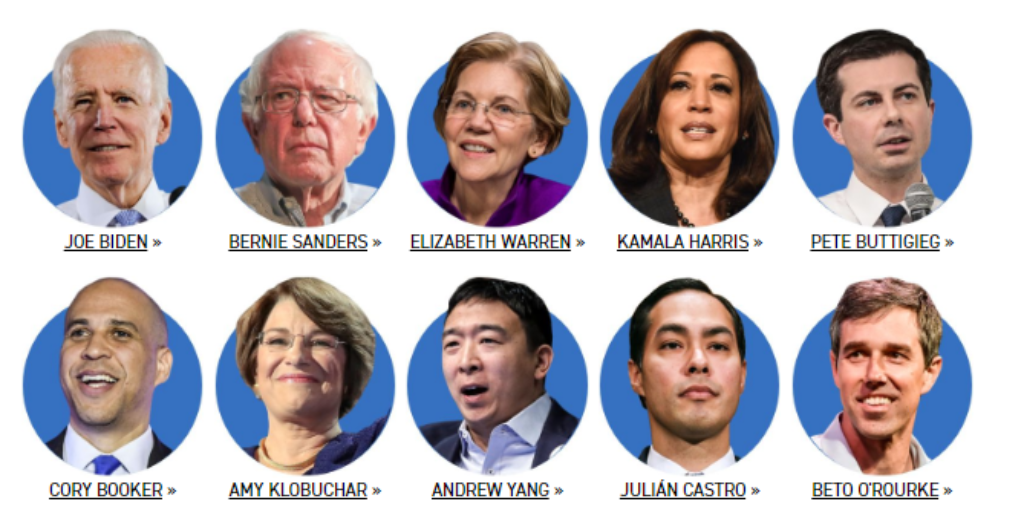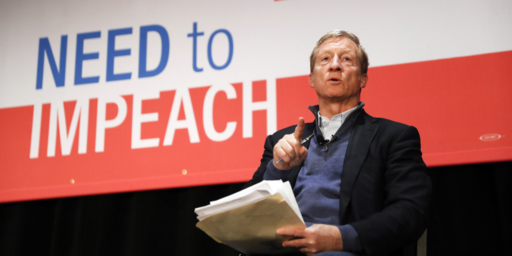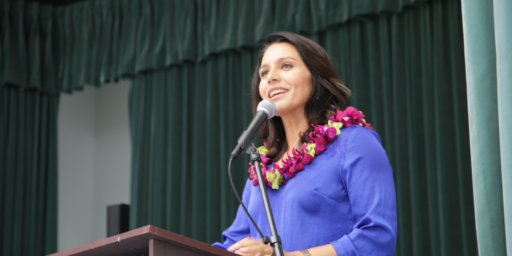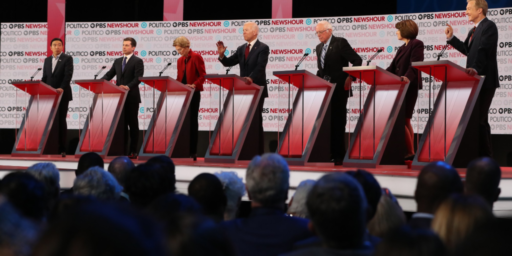Democratic Debate Field Cut In Half
The stage for the third Democratic debate, scheduled for mid-September, is set and its half the size of its predecessors.

With the qualifying deadline passed, the Democratic debate field for the third debate in mid-September has been set, and excludes roughly half of the candidates still running for the Democratic nomination:
The next televised showdown for the Democratic presidential candidates will shrink to one debate stage after only 10 of the hopefuls met the polling and fundraising criteria set by the Democratic National Committee.
If any additional candidates had qualified by Wednesday’s deadline, ABC News, the sponsor of next month’s debate, would have randomly split the candidates in half and held the debate over two back-to-back nights.
Instead, the debate on Sept. 12 will markthe first time that all of the top candidates will debate together. The large field and random assignments had, thus far, prevented Sen. Elizabeth Warren of Massachusetts from appearing with former Vice President Joe Biden or Sen. Kamala Harris of California.
For a time, it appeared billionaire self-funder Tom Steyer would disrupt that. He crossed the fundraising threshold — 130,000 unique donors — two weeks ago, and he sat on the precipice of the polling threshold, having earned 2 percent in three surveys by pollsters approved by the Democratic National Committee.
But he failed to hit the 2-percent mark in a fourth poll, whichwould have made Steyer the 11th qualified candidate, according to POLITICO’s unofficial tracking of the process, and resulted in the debate’s being split over two nights. That included two deadline-eve polls out on Wednesday morning, from Suffolk University/USA Today and Quinnipiac University — both of which showed Steyer at 0 percent.
The 10 candidates who will be on the debate stage in Houston are assured are (from top-to-bottom of their unofficial DNC polling average): Biden (37 percent), Sen. Bernie Sanders of Vermont (21 percent), Warren (20 percent), Harris (17 percent), South Bend Mayor Pete Buttigieg (7 percent), Sen. Cory Booker of New Jersey (3 percent), Sen. Amy Klobuchar of Minnesota (3 percent), entrepreneur Andrew Yang (3 percent), former HUD Secretary Julián Castro (3 percent) and former Rep. Beto O’Rourke of Texas (3 percent).
Steyer wasn’t the only candidate who ended up on the wrong side ofthe bubble. Rep. Tulsi Gabbard of Hawaii has also met the donor threshold, according to her campaign, but only earned 2 percent in two qualifying polls. Self-help author Marianne Williamson crossed the donor mark, but has just one qualifying poll. Sen. Kirsten Gillibrand of New York, who had one qualifying poll but little chance to make the stage, announced on Wednesday that she was dropping out of the race.
But while they will be on the outside looking in on the September debate, those who decide to plod ahead anyway still have a chance to make the stage for the fourth debate in October. The same rules apply: 130,000 donors, and 2 percent in four qualifying polls.
A date and sponsor for the October debate has yet to be announced, and the qualifying deadline will be two weeks prior to the date of the debate. That gives candidates who don’t make the cut for the third debate roughly an additional three-to-six weeks, depending on the scheduling for October, to qualify for the fourth debate. (Because no debate sponsor has been announced for the fourth debate, it’s not clear whether, like the first three, the stage would be capped at 10 candidates per night.)
Despite this future prospect, both Steyer and Gabbard did not concede a place at the third debate without a fight. Both complained publicly about the scarcity of polls — there have been 21 polls in the DNC’s qualifying period, including 8 in early-nominating states — and have asked the DNC to consider polls from firms or media sponsors that weren’t on the party’s initial list. (The Gabbard campaign, in a memo sent to reporters on Monday, calling the DNC’s rules “cockamamie criteria.”)
The main criticism of the DNC criteria from analysts echoes that from the Steyer campaign, namely that it fails to include enough early-state polling while relying heavily on national polls. This arguably works to the detriment of less-known candidates who, while they have spent a lot of time on the ground in states in Iowa and New Hampshire, don’t have the same level of national exposure that the top-tier candidates do. This was also a topic of discussion among the pundits on MSNBC’s MTP Daily late yesterday afternoon. The problem I see with that argument, though, is that it is criticizing the DNC for something over which it has no control.
The most recent Iowa poll was released nearly a month ago and largely reflected the state of the race at that time on the national level. Steyer stands at 2.5% in the average in the Hawkeye State, but that’s largely due to his performance in one poll, a CBS/YouGov poll from mid-July. Tulsi Gabbard has 1.5% average in the state due mainly to the fact that she got 2% in a Monmouth poll in the state. Similarly, the most recent poll in New Hampshire was in early August, the most recent poll in Nevada was in mid-August, and the most recent poll in South Carolina was in early August. By way of contrast the there’s new national polling on at least a weekly basis.
Nearly all of these early state polls show at least one of the candidates who failed to qualify for the third debate doing better than they have in the national polling. However, there were not enough of them released by yesterday to help candidates like Steyer or Gabbard reach the threshold they needed to in order to get into the debate. There really isn’t anything the DNC can do about that, though. They don’t conduct the polls. nor should they. Instead, the polls are conducted mostly by news outlets in partnership with reputable polling firms. These polls cost money, though, and neither the news outlets nor the polling firms have budgets that cand justify frequent polling of every state. Additionally, national polling is generally easier because there is a larger potential pool of respondents that can be contacted. For the most part, state-level polling doesn’t become more common until we get closer to the primary or caucus in that state.
In any case, the blunt truth of the matter is that none of the ten people that are excluded from the third debate are going to be the Democratic nominee for President. Even if they manage to defy the odds and qualify for the October debate, they’re unlikely to climb significantly in the polling at the national or state level to the point where they are contenders. Excluding them now and allowing the race to coalesce around the five or six candidates that can be called “contenders” more or less isn’t an egregious move on the part of the DNC. Finally, it isn’t up to the DNC or the network sponsoring the debate to give any of these candidates free air time. The criteria for this debate were announced months ago and were well-known before most of these candidates got in the race. Whining about the rules now doesn’t strike me as especially mature.
What all this means, of course, is that we’ll have just one night of debate, and it will include all of the top four candidates — former Vice-President Biden, and Senators Sanders, Warren, and Harris — will be on the stage at the same time. While they will have to share that stage with six other candidates, it’s likely they these four will receive most of the attention and how that comes across could have a significant impact on the future direction of the race. Ideally, we would have a debate featuring just the top five candidates but we’re likely to get to that point at some point in the fall in any case.
Photo via Politico




I’m pretty pleased that Williamson, Steyer and Gabbard are off the list. And I totally agree that complaining at this juncture is dumb. Did Gabbard think that this next debate was going to vault her into the Biden/Harris/Warren stratosphere? If you are at 1-2% at this point and you care seriously about your policies, it’s time to find a candidate you can support and work on that angle.
Of course these three in particular are vanity/public awareness candidates.
I’d add the early primary/caucus states already have an outsize influence in the race, and they don’t need to be given more by the DNC.
I would have liked one additional candidate to qualify, just to split it across two nights. The ten person format is terrible.
I don’t really care which other candidate. Klobuchar, Beto, someone like that who has held elective office. Not a complete novelty act.